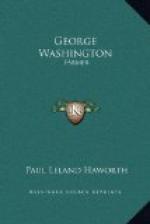[4] “On sixteen square rod of ground in my lower pasture, I put 140 Bushels of what we call Marle viz on 4 of these, No. Wt. corner were placed 50 bushels—on 4 others So. Wt. corner 30 bushels—on 4 others So. Et. corner 40 bushels—and on the remaining 4-20 bushels. This Marle was spread on the rods in these proportions—to try first whether what we have denominated to be Marie possesses any virtue as manure—and secondly—if it does, the quantity proper for an acre.” His ultimate conclusion was that marl was of little benefit to land such as he owned at Mount Vernon.
Many of his experiments were made in what he called his “Botanical Garden,” a plot of ground lying between the flower garden and the spinner’s house. But he had experimental plots on most or all of his plantations, and each day as he made the rounds of his estate on horseback he would examine how his plants were growing or would start new experiments.
The record of failures is, of course, much greater than of successes, but that is the experience of every scientific farmer or horticulturist who ventures out of the beaten path. Even Burbank, the wizard, has his failures—and many of them.
One of Washington’s successes was what he called a “barrel plough.” At that time all seed, such as corn, wheat and oats had to be sown or dropped by hand and then covered with a harrow or a hoe or something of the kind. Washington tried to make a machine that would do the work more expeditiously and succeeded, though it should be said that his plans were not altogether original with him, as there was a plan for such a machine in Duhamel and another was published by Arthur Young about this time in the Annals of Agriculture, which Washington was now perusing with much attention. Richard Peters also sent yet another plan.
Washington’s drill, as we should call it to-day, consisted of a barrel or hollow cylinder of wood mounted upon a wheeled plow and so arranged that as the plow moved forward the barrel turned. In the barrel, holes were cut or burnt through which the corn or other seed could drop into tubes that ran down to the ground. By decreasing or increasing the number of holes the grain could be planted thicker or thinner as desired. To prevent the holes from choking up he found it expedient to make them larger on the outside than on the inside, and he also found that the machine worked better if the barrel was not kept too full of seed. Behind the drills ran a light harrow or drag which covered the seed, though in rough ground it was necessary to have a man follow after with a hoe to assist the process. A string was fastened to this harrow by which it could be lifted around when turning at the ends of the rows, the drill itself being managed by a pair of handles.




